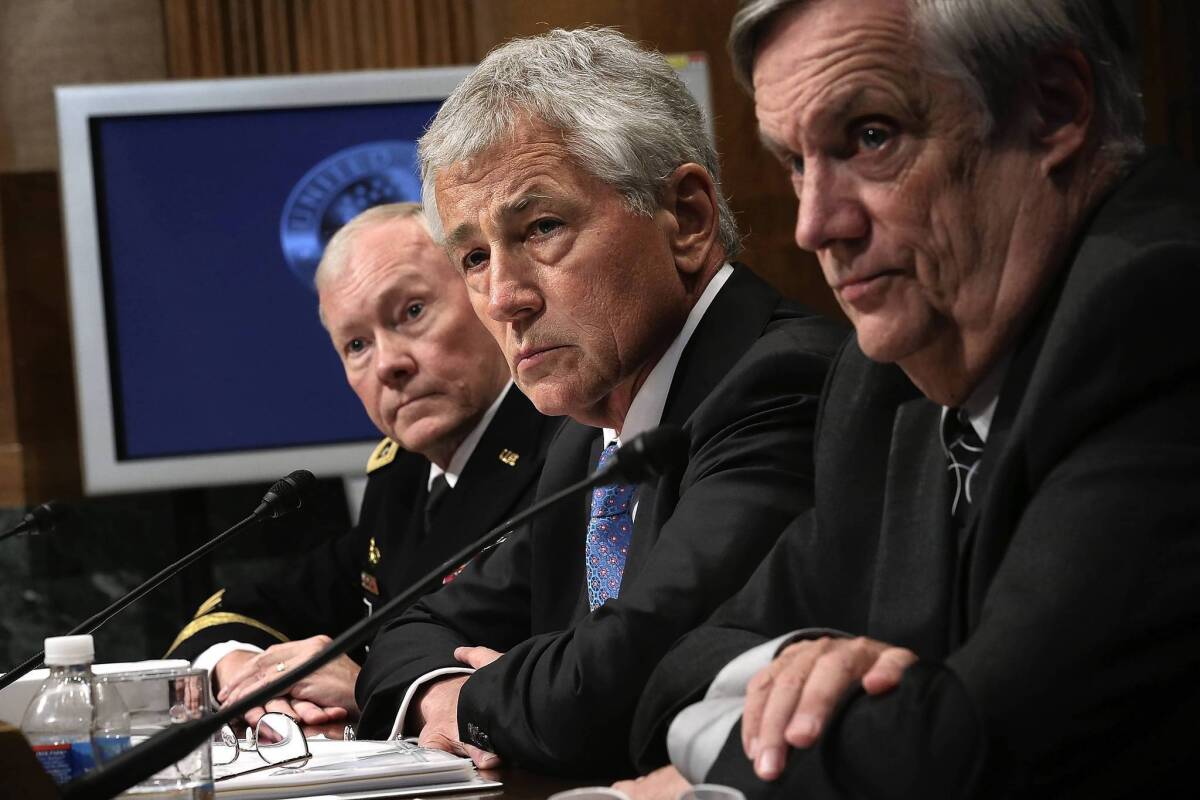Pentagon urges Congress to rein in sequester cuts to Defense budget

- Share via
WASHINGTON — Senior Pentagon officials pleaded with Congress on Thursday to halt or at least delay additional budget cuts, arguing that they would produce an undersized, ill-equipped military that would have to scale back its operations around the world.
“It will be truly shameful if we allow this force to travel further down the path to becoming hollow,” Adm. James Winnefeld, vice chairman of the Joint Chiefs of Staff, told the House Armed Services Committee. “We need your help in removing the risk of financial uncertainty.”
The dire warnings were the latest Pentagon attempt to halt or shrink the $54 billion in 2014 and $500 billion over 10 years that is to be slashed from the budget as a result of automatic spending cuts that took effect this year after Congress and the White House failed to agree on a specific budget plan.
But the push to limit the cuts faces a problem: The first round earlier this year — which trimmed the budget by $37 billion — has not proven as immediately calamitous as Pentagon officials warned, making the task of preventing the next installment even tougher.
After warning that 650,000 Defense Department civilian workers would face 22 furlough days this year, officials recently announced that they might be able to reduce that to just six days by finding savings elsewhere in the $498-billion defense budget.
Gordon Adams, a defense budget expert at American University who served in the Office of Management and Budget during the Clinton administration, said that even though the Pentagon was still fighting the idea of reducing the defense budget by $500 billion over the next decade, such a reduction was “consistent with prior defense drawdowns” after the Cold War and other major conflicts.
The administration and Congress could find substantial savings by reducing what Adams calls the Pentagon’s overhead: hundreds of thousands of military personnel and contractors in administrative jobs that are either unnecessary or that could be consolidated, yielding billions of dollars in savings.
“If you are really concerned about the size of the force and about maintaining the technological edge, you put the pedal to the metal on overhead. That’s where you get the money,” Adams said in an interview.
Defense Secretary Chuck Hagel recently announced a 20% reduction in the staffs of the Joint Chiefs and the secretary of Defense’s office, but that will yield at best only $40 billion over the next 10 years, Adams said.
Pentagon officials reminded the committee that the Army, Navy, Air Force and Marines had already been forced to cut training and eliminate unnecessary operations.
If the next $52-billion installment goes into effect in January, the cuts would force further reductions in training, maintenance and weapons-buying, Winnefeld and Deputy Defense Secretary Ashton Carter told the committee.
“If these caps continue in future years, the department will have to make sharp cuts with far-reaching consequences that will limit combat power, reduce readiness and irrevocably alter the way the military supports the national security interests of the United States,” Winnefeld and Carter added in written testimony.
Congress has made no move to halt the so-called sequester cuts, in part because of a standoff between the White House and congressional Republicans over the mix of spending cuts and revenue increases that should be in a new budget deal.
Rep. Adam Smith of Washington, the senior Democrat on the committee, said there was now less pressure for a deal to halt sequestration. “People say, ‘Well, the sky didn’t fall; the economy didn’t completely collapse when sequestration happened,’” he said.
Defense officials urged Congress to consider cutting personnel and benefits costs for the military — areas of the budget that have long been considered off-limits — by imposing higher healthcare co-payments, limiting pay raises and reducing housing allowances. They also urged Congress to consider closing unnecessary military bases.
Without those steps, the Pentagon may be forced to cut more than 100,000 additional soldiers from the Army, which is already planning to drop from about 570,000 to 490,000 by 2017, Hagel said at a news conference Wednesday.
The Marine Corps could shrink to as few as 150,000 Marines, instead of slimming from 250,000 to 182,000. The Air Force could have to close down as many as five combat squadrons, as well as bombers and cargo aircraft, and the Navy could see the number of aircraft carriers reduced from 11 to as few as eight.
More to Read
Sign up for Essential California
The most important California stories and recommendations in your inbox every morning.
You may occasionally receive promotional content from the Los Angeles Times.














